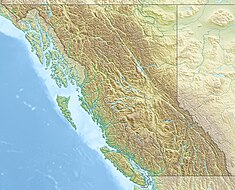TheKootenay Canalis ahydroelectricpower station, located 19 km downstream ofNelson, British Columbia,Canada.Where theKootenay Riverflows out of the reservoir formed by theCorra Linn DamonKootenay Lake.,[3]a canal diverts water toBC Hydro'sKootenay Canal Generating Station.Its construction was a result of theDuncan DamandLibby Damproviding year round flows into Kootenay Lake. The powerhouse was completed in 1976.
| Kootenay Canal | |
|---|---|
| Official name | Kootenay Canal Generating Station |
| Location | Kootenays,British Columbia,Canada |
| Coordinates | 49°27′10″N117°31′05″W/ 49.45278°N 117.51806°W |
| Opening date | 1976 |
| Reservoir | |
| Creates | Kootenay Lake |
| Surface area | 38,900 ha (389 km2) |
| Power Station | |
| Operator(s) | BC Hydro |
| Hydraulic head | 84m |
| Turbines | 4 |
| Installed capacity | 588MW[1] |
| Capacity factor | 48.2% |
| Annual generation | 2482GWh[2] |

Diversion
editWater enters the canal from the Corra Linn headpond and for much of the year is diverted 4.5 km pastCorra Linn Dam,City of Nelson Powerhouse,[4]Upper Bonnington,Lower BonningtonandSouth Slocan.[5]By diverting water past the older and smaller dams Kootenay Canal can generate more power due to greaterheadand more modern generators.[6]
Powerhouse
editAfter passing through the canal and dropping 84 meters through the powerhouse containing fourwater turbine-electrical generatorunits, water then returns to the river.[7] Power generated at Kootenay Canal plant is fed into BC Hydro's provincialgridvia two lines running south to Selkirk Switching Station, near the Seven Mile Generating Station.[7]
Expansion
editIn 1999 the four turbines were upgraded and increased the output to a total of 583MW.[8][9]Kootenay Canal andSeven Milegenerating stations together supplied 10% of BC Hydro's electricity requirements.[10]
Canal plant agreement
editUnder the terms of theColumbia River Treaty,the Province of British Columbia is entitled to downstream benefits resulting from dam construction. Both theDuncan Damabove Kootenay lake and Lake Koocanusa created by theLibby Dam200 kilometers upstream in Montana, are covered by the treaty and result in a constant supply of water into Kootenay Lake, and to the manyColumbia River damsdownstream. BC Hydro is allowed to divert water from five older hydroelectric plants owned byFortisBCand theCity of Nelson.Fortis receives the amount of power their generating stations would have produced. Downstream theBrilliant Damis in the agreement. On thePend d'Oreille RivertheSeven Mile Damand theWaneta Damare also in the agreement.[11]
See also
editReferences
edit- ^"Columbia Region".BC Hydro.Archived fromthe originalon March 30, 2020.RetrievedApril 29,2020.
- ^"Kootenay Canal".Carbon Monitoring for Action.Archived fromthe originalon May 10, 2017.
- ^"Kootenay, Lake".BC Geographical Names.
- ^"City of Nelson - History".nelson.ca.Archived fromthe originalon 2013-11-11.Retrieved2011-07-07.
- ^"Kootenay Canal - the Dams | Balance of Power".Archived fromthe originalon 2011-06-29.Retrieved2011-07-07.
- ^"New Development: Partnering in Power Development In British Columbia".hydroworld.com.
- ^ab"Kootenay Canal".bchydro.com.
- ^"Page or File Not Found"(PDF).bchydro.com.Archived fromthe original(PDF)on 2012-03-19.Retrieved2011-07-06.
- ^BC Hydro (June 2010),Quick Facts for the Year Ended March 31, 2010(PDF),archived fromthe original(PDF)on March 5, 2012,retrieved2011-07-07
- ^"Page or File Not Found".bchydro.com.Archived fromthe originalon 2011-06-12.Retrieved2011-07-06.
- ^"Page or File Not Found"(PDF).bchydro.com.Archived fromthe original(PDF)on 2012-03-19.Retrieved2011-07-06.
